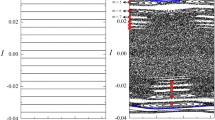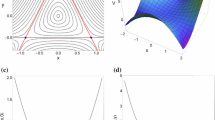Abstract
The spectra of ‘stretching numbers’ (or ‘local Lyapunov characteristic numbers’) are different in the ordered and in the chaotic domain. We follow the variation of the spectrum as we move from the centre of an island outwards until we reach the chaotic domain. As we move outwards the number of abrupt maxima in the spectrum increases. These maxima correspond to maxima or minima in the curve a(θ), where a is the stretching number, and θ the azimuthal angle. We explain the appearance of new maxima in the spectra of ordered orbits. The orbits just outside the last KAM curve are confined close to this curve for a long time (stickiness time) because of the existence of cantori surrounding the island, but eventually escape to the large chaotic domain further outside. The spectra of sticky orbits resemble those of the ordered orbits just inside the last KAM curve, but later these spectra tend to the invariant spectrum of the chaotic domain. The sticky spectra are invariant during the stickiness time. The stickiness time increases exponentially as we approach an island of stability, but very close to an island the increase is super exponential. The stickiness time varies substantially for nearby orbits; thus we define a probability of escape Pn(x) at time n for every point x. Only the average escape time in a not very small interval Δx around each x is reliable. Then we study the convergence of the spectra to the final, invariant spectrum. We define the number of iterations, N, needed to approach the final spectrum within a given accuracy. In the regular domain N is small, while in the chaotic domain it is large. In some ordered cases the convergence is anomalously slow. In these cases the maximum value of ak in the continued fraction expansion of the rotation number a = [a0,a1,... ak,...] is large. The ordered domain contains small higher order chaotic domains and higher order islands. These can be located by calculating orbits starting at various points along a line parallel to the q-axis. A monotonic variation of the sup {q}as a function of the initial condition q0 indicates ordered motions, a jump indicates the crossing of a localized chaotic domain, and a V-shaped structure indicates the crossing of an island. But sometimes the V-shaped structure disappears if the orbit is calculated over longer times. This is due to a near resonance of the rotation number, that is not followed by stable islands.
Similar content being viewed by others
References
Abarbanel, H. D. I., Brown, R., and Kennel, M. B.: 1991, Int. J. Mod. Phys. B5, 134.
Benzi, R., Paladin, G., Parisi, G., and Vulpiani, A.: 1985, J. Phys. A18, 2157.
Celletti, A. and Froeschlé, C.: 1995, Int. J. Bifurc. Chaos 5(6).
Contopoulos, G.: 1967, Bull. Astron. 3e Ser. 2, 223.
Contopoulos, G.: 1970, Astron. J. 75, 96.
Contopoulos, G.: 1971, Astron. J. 76, 147.
Contopoulos, G., Giorgilli, L., and Galgani, A.: 1978, Phys. Rev. A18, 1183.
Contopoulos, G., Varvoglis, H., and Barbanis, B.: 1987, Astron. Astrophys. 172, 55.
Contopoulos, G., Voglis, N., Efthymiopoulos, C. and Grousousakou, E.: 1995a, ' Waves in Astrophysics ', J. Hunter and R. Wilson (eds), N. York Acad. Sci. Annals, Vol. 773, 145.
Contopoulos, G., Grousousakou, E., and Voglis, N.: 1995b, Astron. Astrophys. 304, 374.
Contopoulos, G. and Voglis, N.: 1996, Cel. Mech. Dyn. Astron. 64, 1.
Crisanti, A., Paladin, G., and Vulpiani, A.: 1988, J. Stat. Phys. 53, 583.
Froeschlé, C., Froeschlé, Ch., and Lohinger, E.:1993, Cel. Mech. Dyn. Astron. 56, 307.
Fujisaka, H.: 1983, Prog. Theor. Phys. 70, 1264.
Grassberger, P. and Procaccia, I.: 1984, Physica D 13, 34.
Grassberger, P., Badii, R., and Politi, A.: 1988, J. Stat. Phys. 51, 135.
Grobgeld, D., Pollak, E., and Zakrzewski, J.: 1992, Physica D 5, 368.
Kandrup, H. E. and Mahon, M. E.: 1994a, Astron. Astrophys. 290, 762.
Kandrup, H. E. and Mahon, M. E.: 1994b, Three-dimensional Systems, H. E. Kandrup, S. T. Gottesman, and J. R. Ipser} (eds), N. York Acad. Sci. Annals, Vol. 751, p. 93.
Laskar, J.: 1994, Workshop on Non-Linear Dynamics in Particle Accelerators, Arcidosso.
Laskar, J., Froeschlé, C., and Celletti, A.: 1992, Physica D 56, 253.
Lega, E. and Froeschlé. C.:1996, Physica D 95, 97.
Morbidelli, A. and Giorgilli, A.: 1995, J. Stat. Phys. 78, 1607.
Nicolis, J. S., Meyer-Kress, G., and Haubs, G.: 1983, Z. Naturfosch. 38a, 1157.
Sepulveda, M. A., Badii, R., and Pollak, E.: 1989, Phys. Rev. Lett. 63, 1226.
Shirts, R. B. and Reinhardt, W. P.: 1982, J. Chem. Phys. 77, 5204.
Smith, H. and Contopoulos, G.: 1996, Astron. Astrophys. 314, 795.
Udry, S. and Pfenniger, D.: 1988, Astron. Astrophys. 198, 135.
Voglis, N. and Contopoulos, G.: 1994, J. Phys. A27, 4899.
Author information
Authors and Affiliations
Rights and permissions
About this article
Cite this article
Contopoulos, G., Voglis, N., Efthymiopoulos, C. et al. Transition spectra of dynamical systems. Celestial Mechanics and Dynamical Astronomy 67, 293–317 (1997). https://doi.org/10.1023/A:1008275829979
Issue Date:
DOI: https://doi.org/10.1023/A:1008275829979




